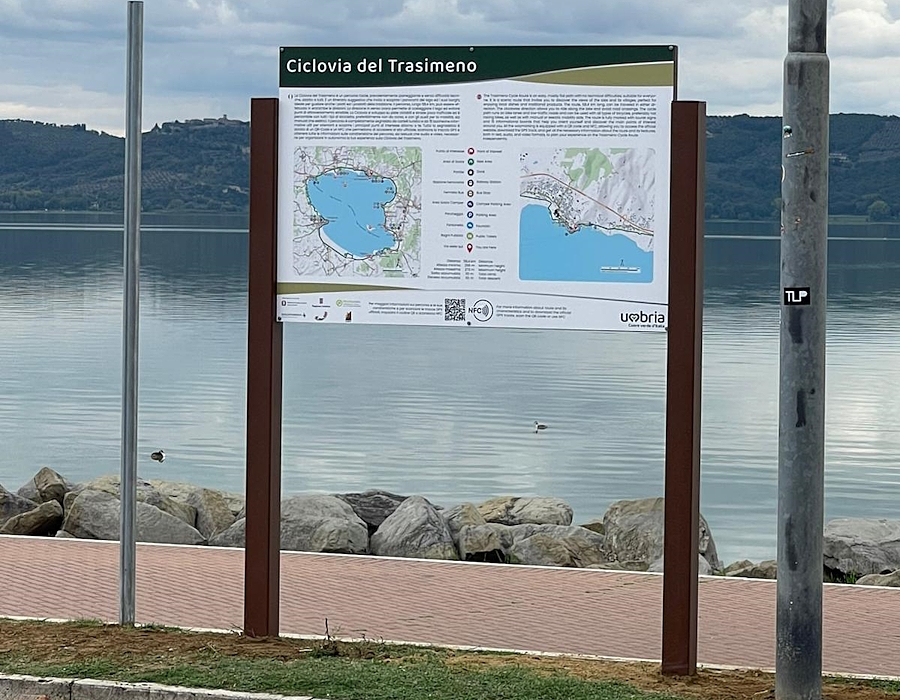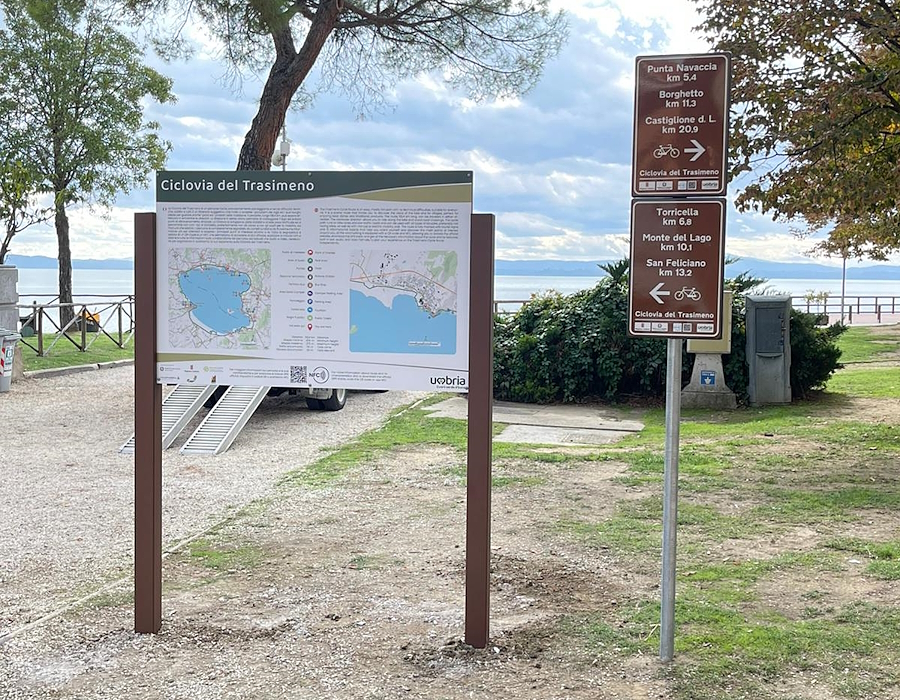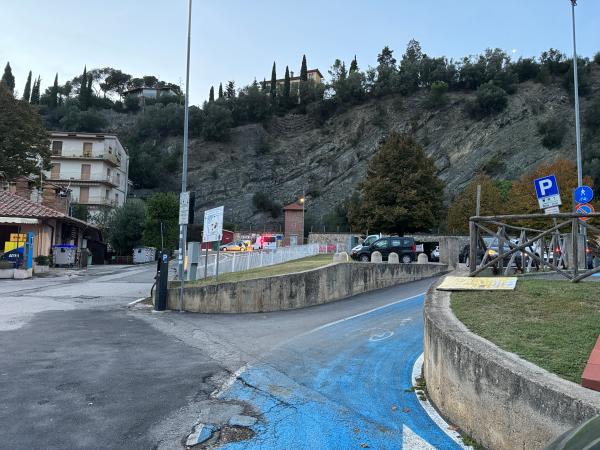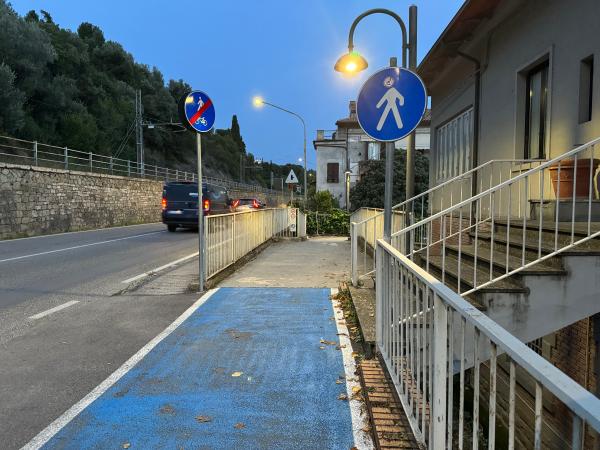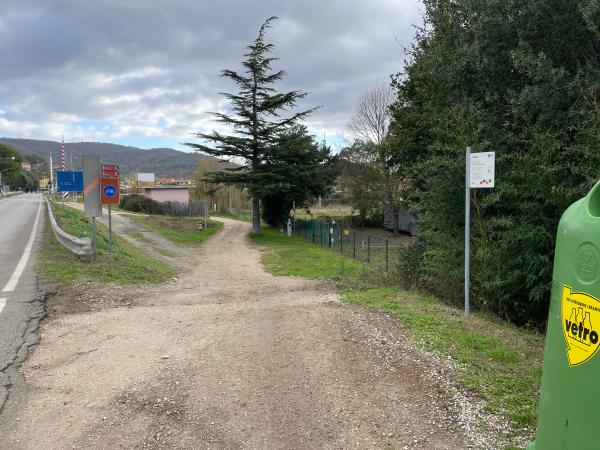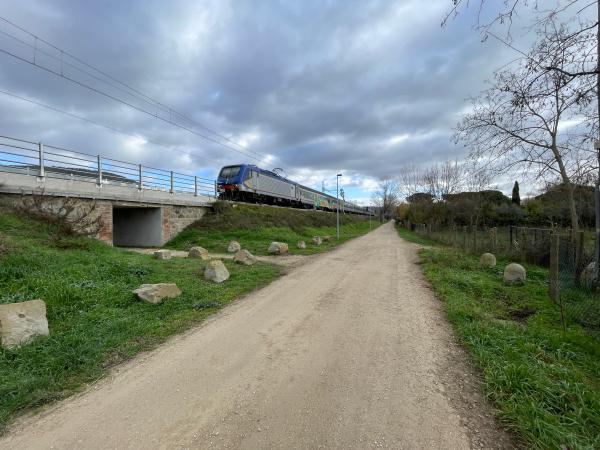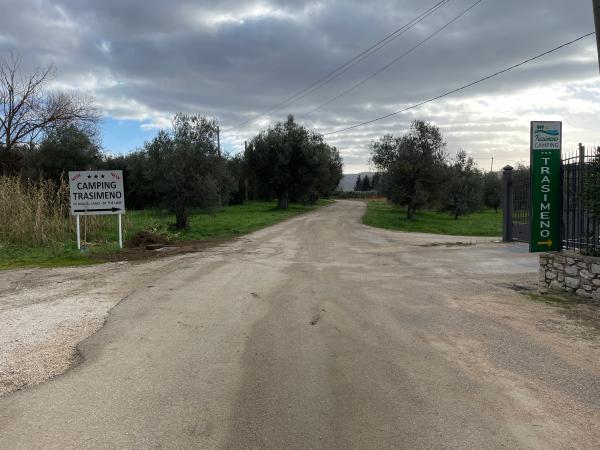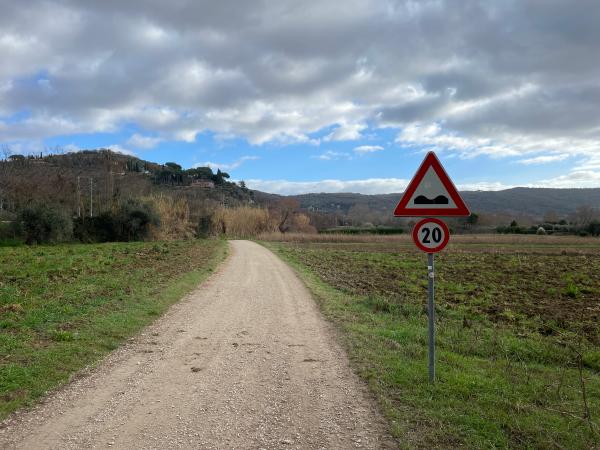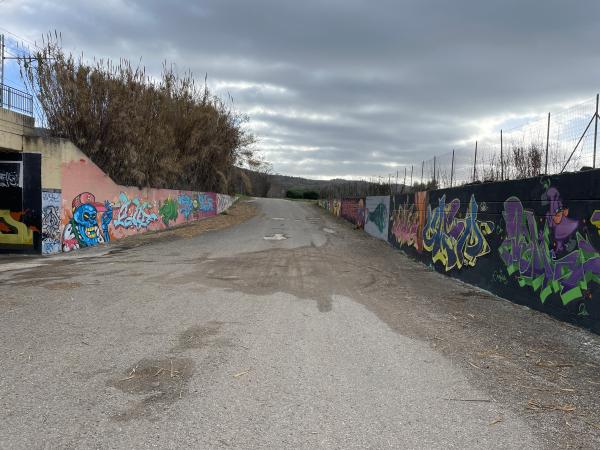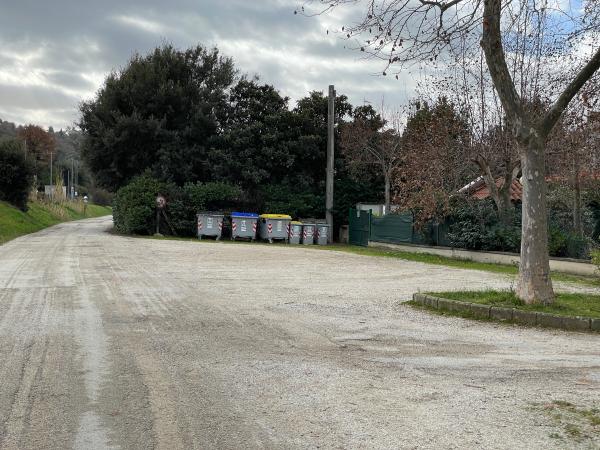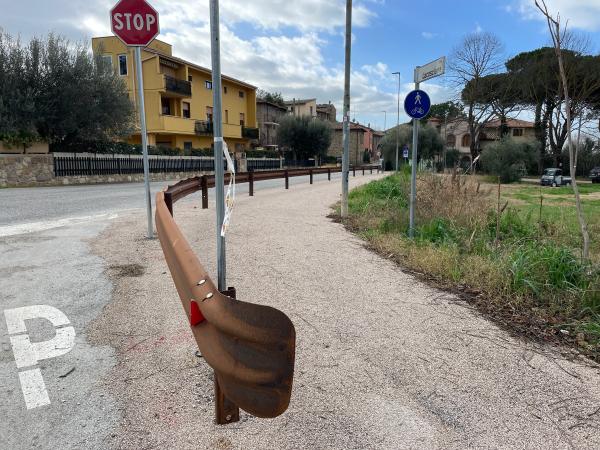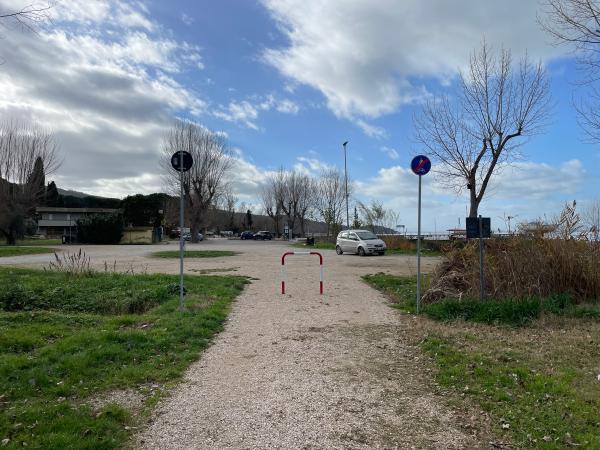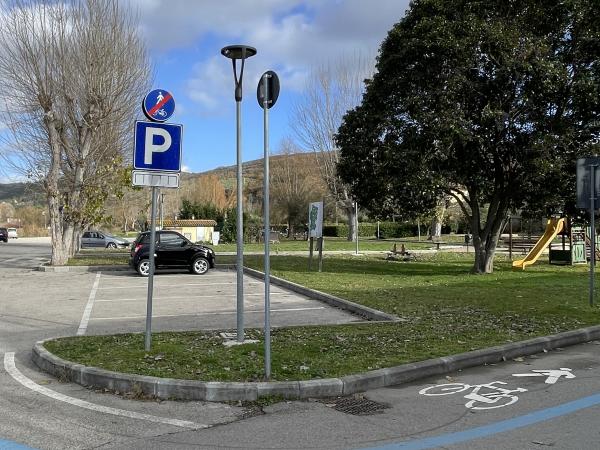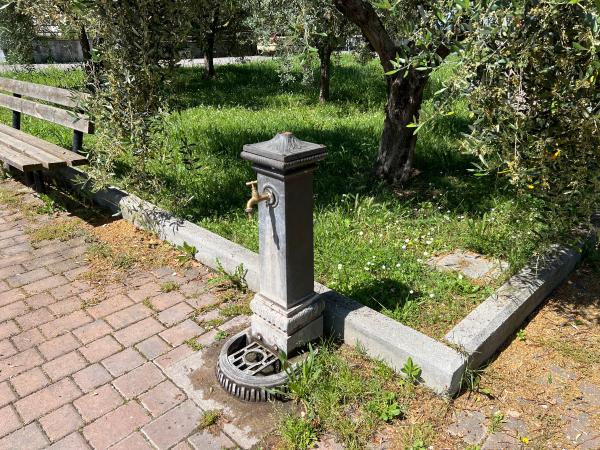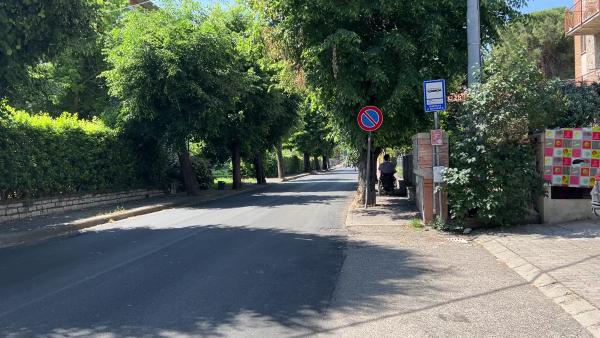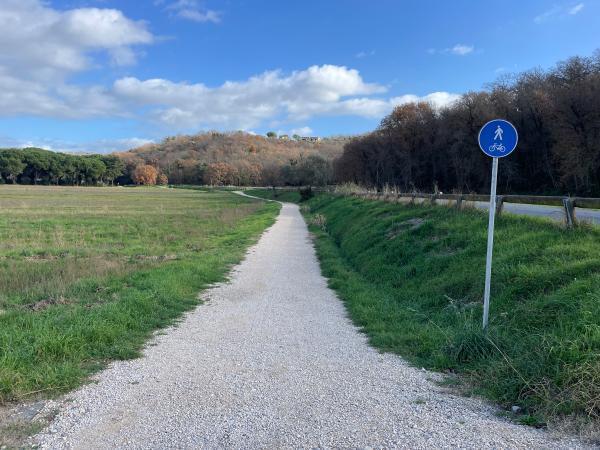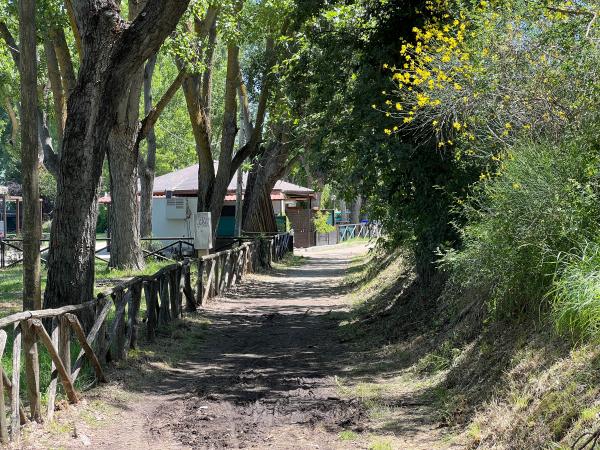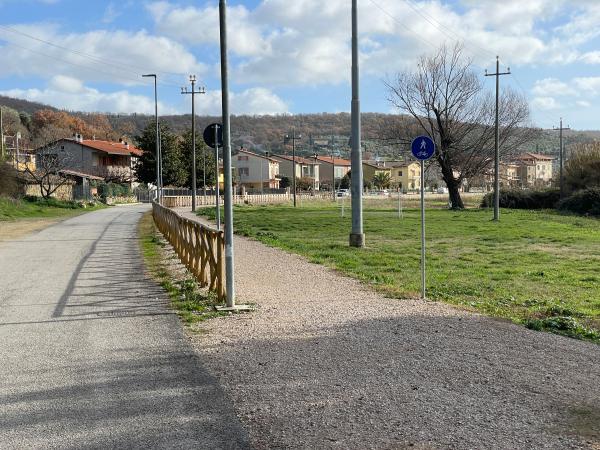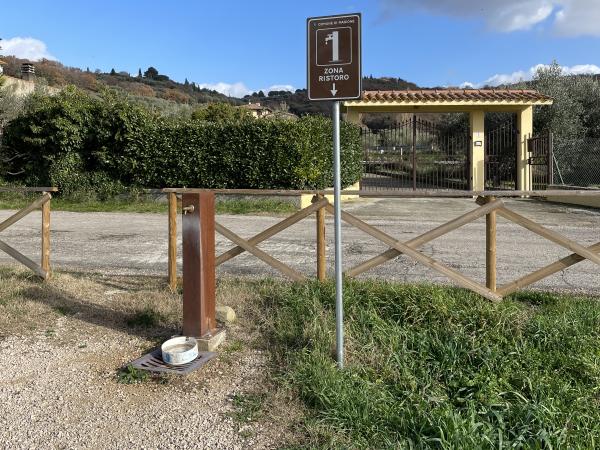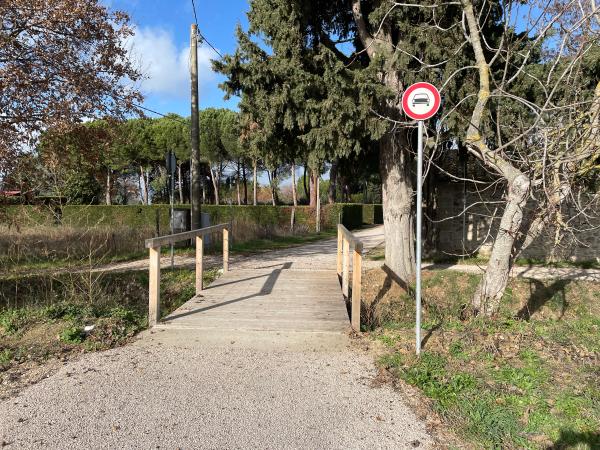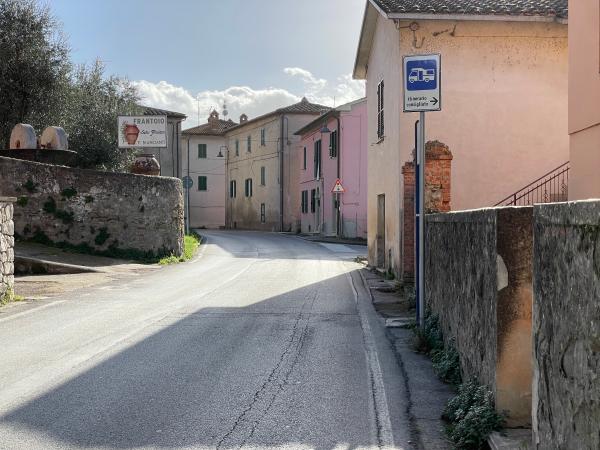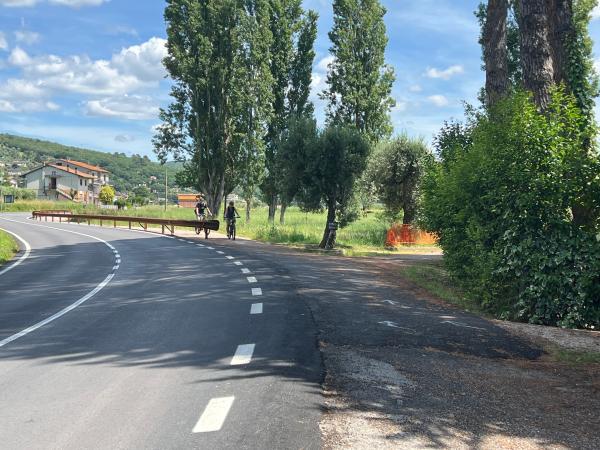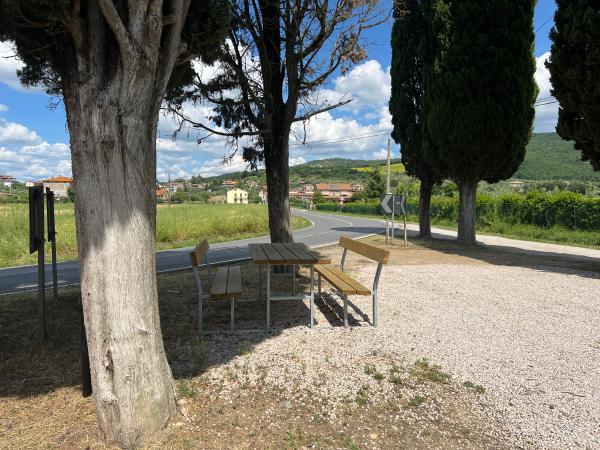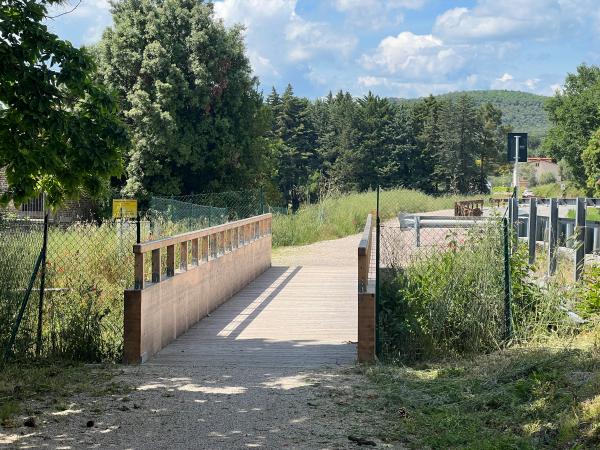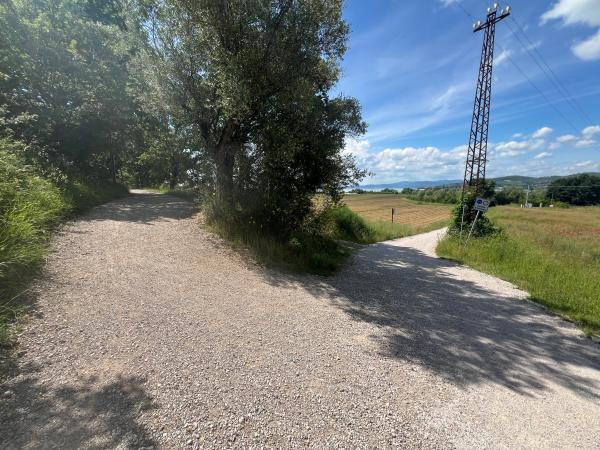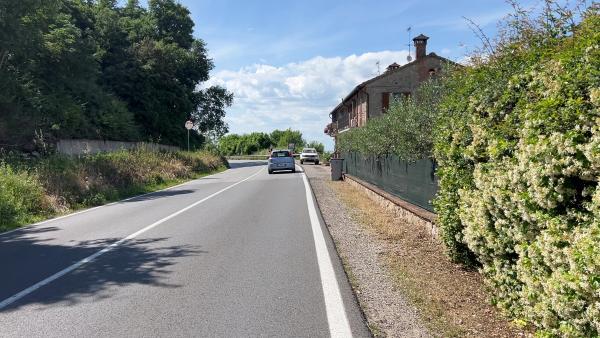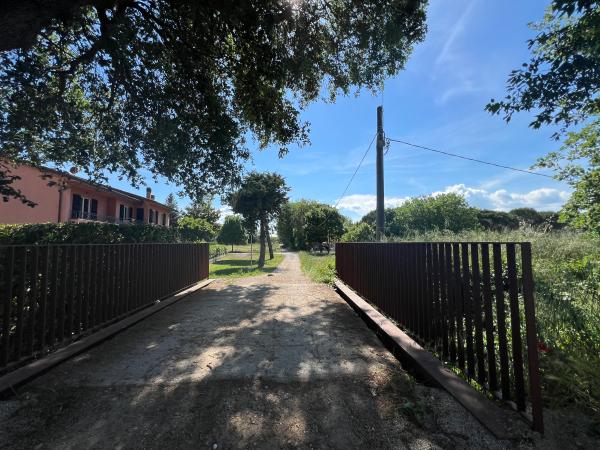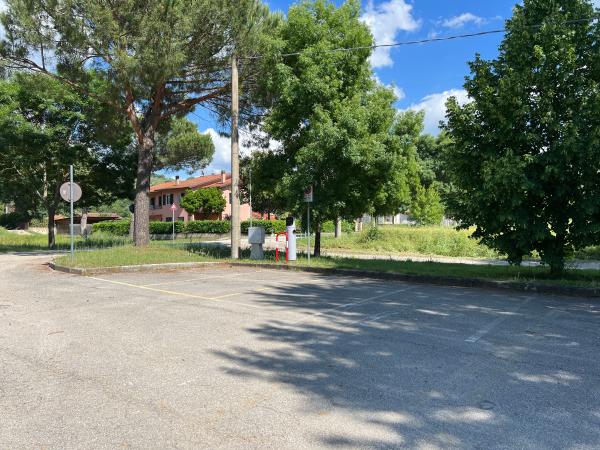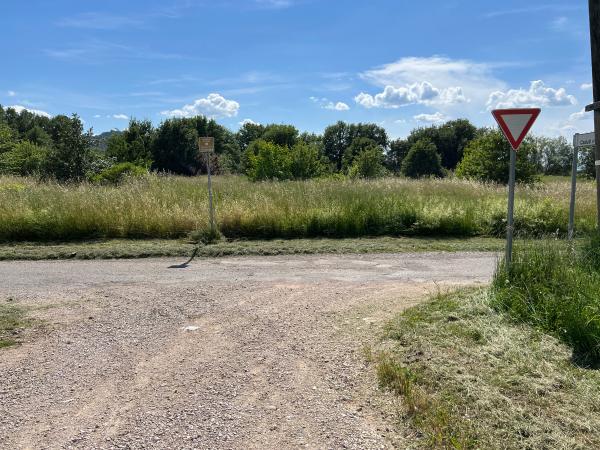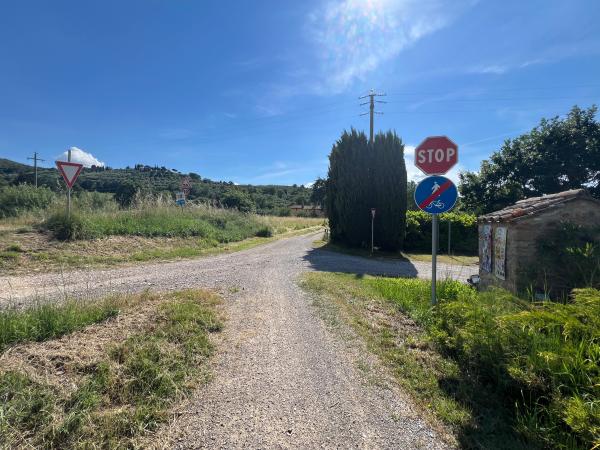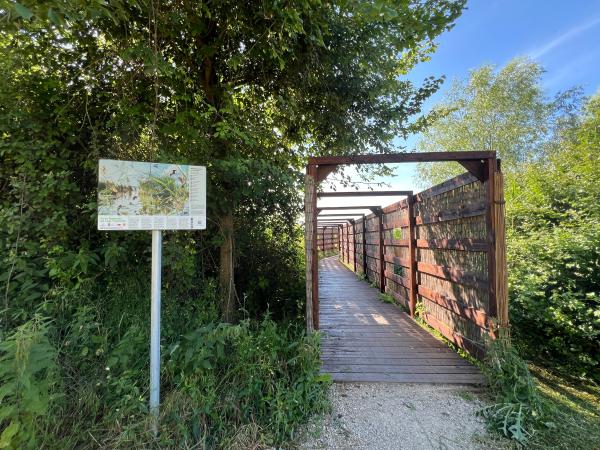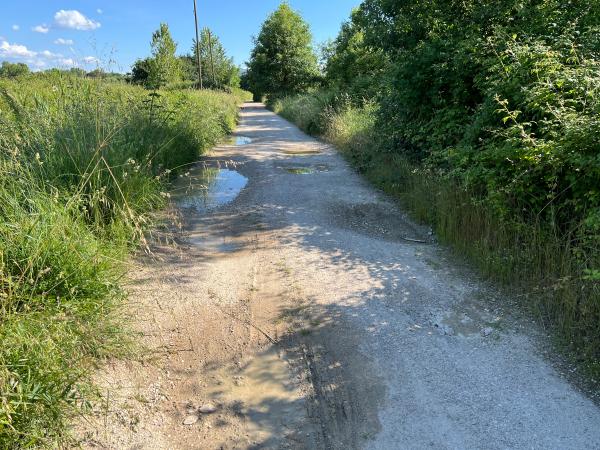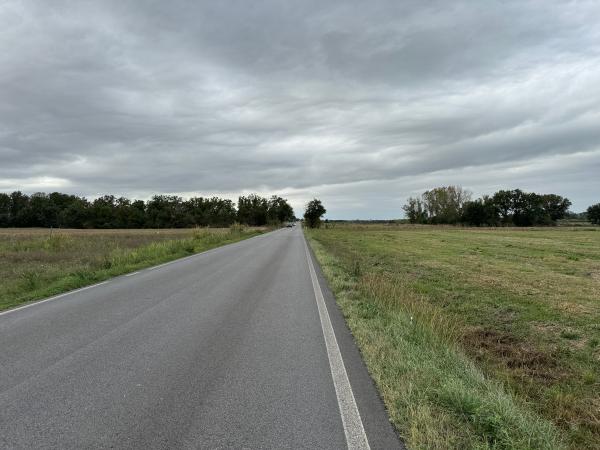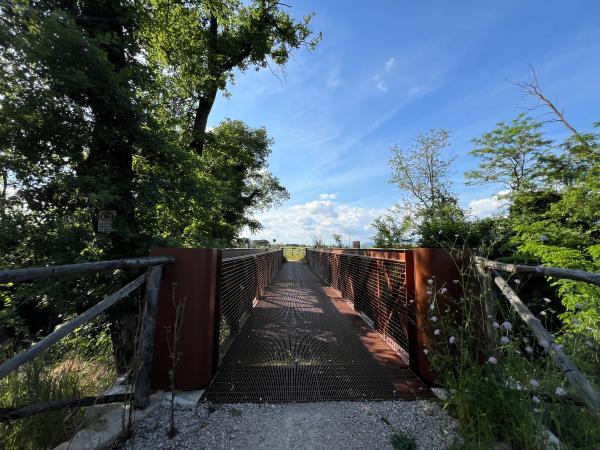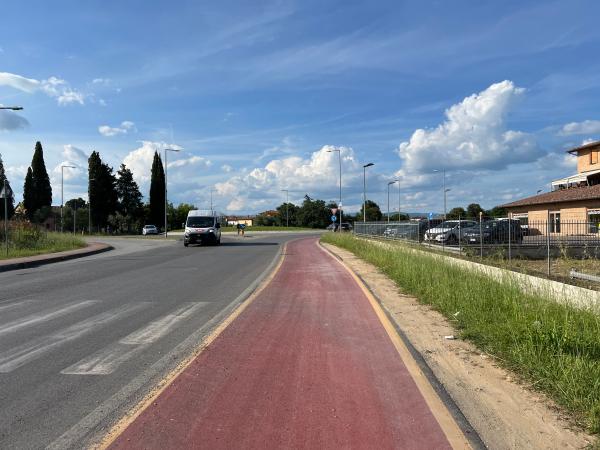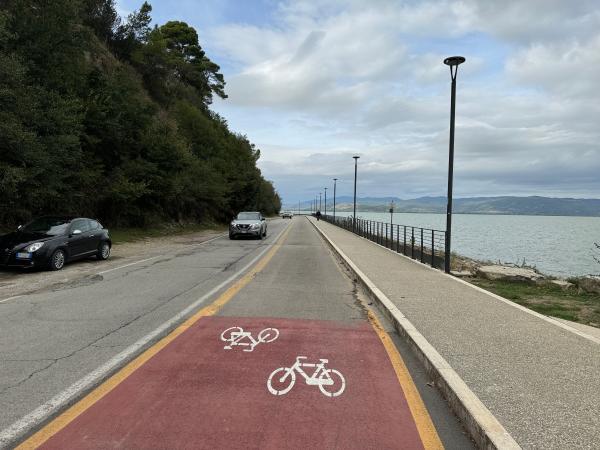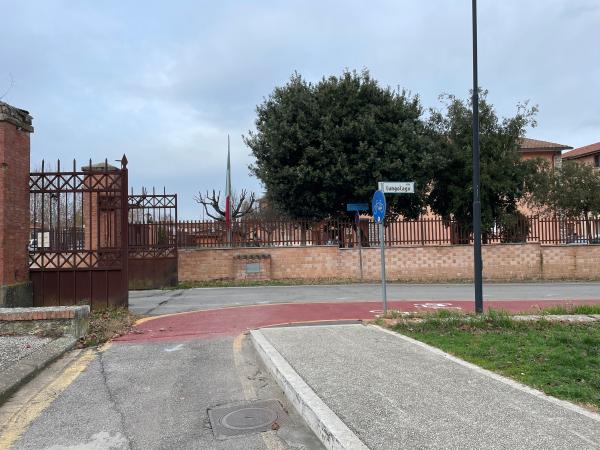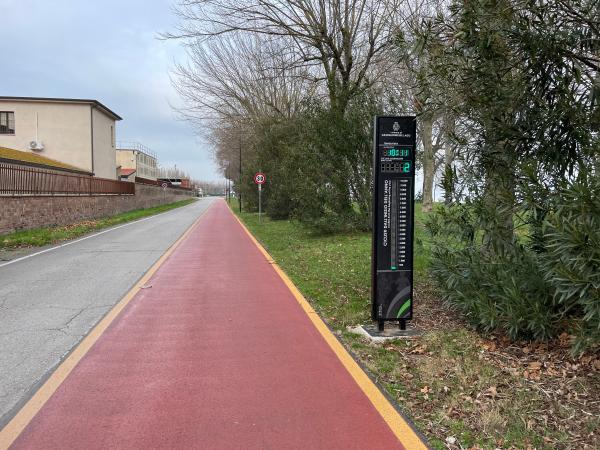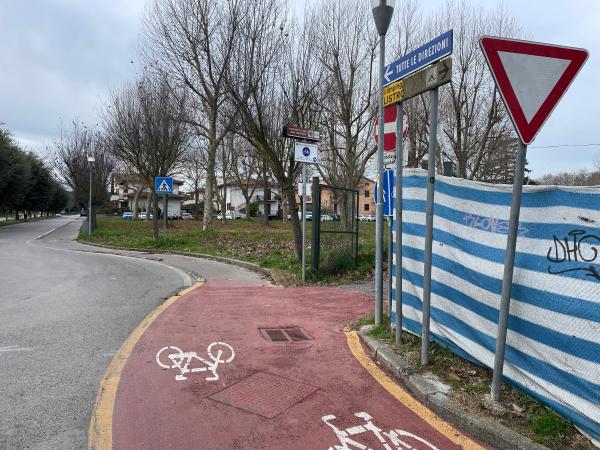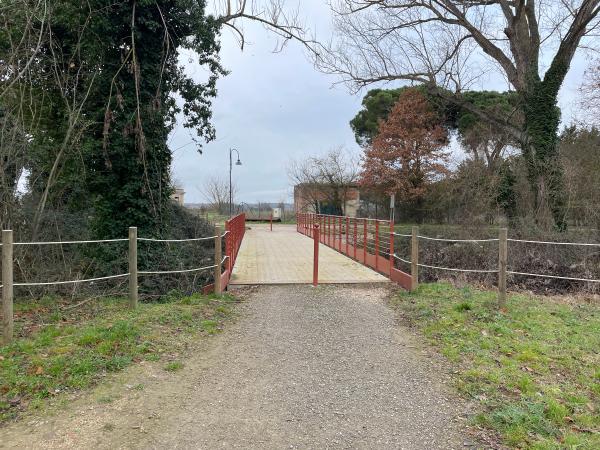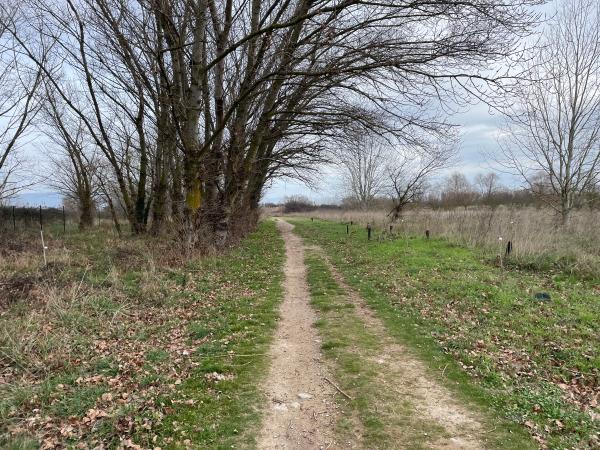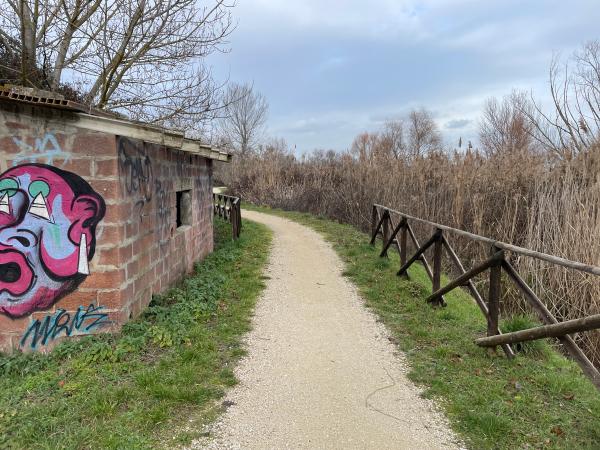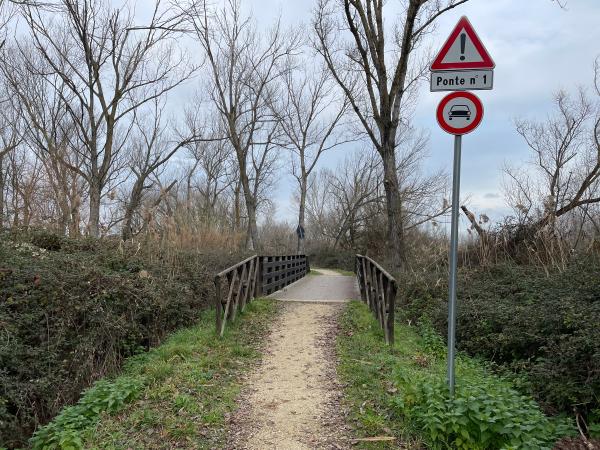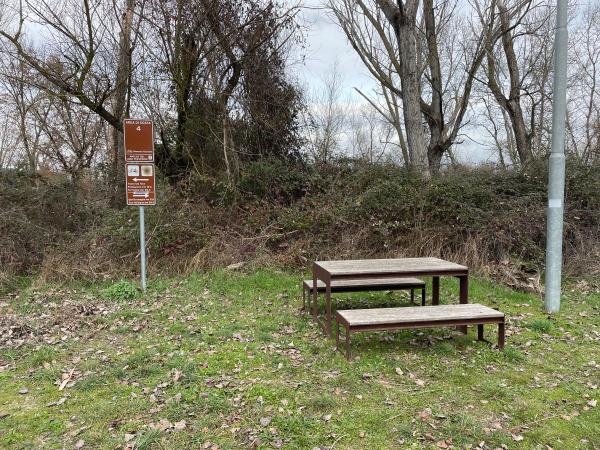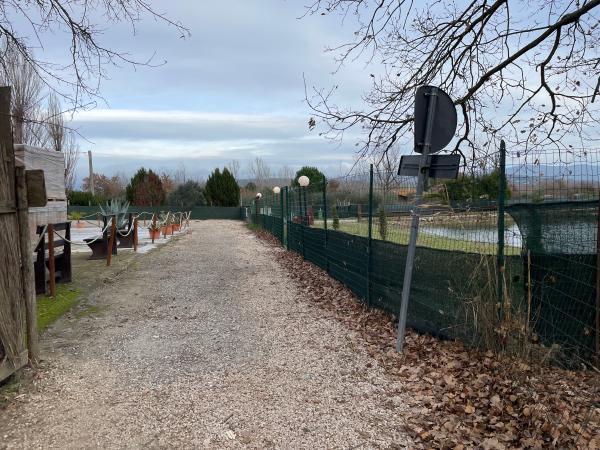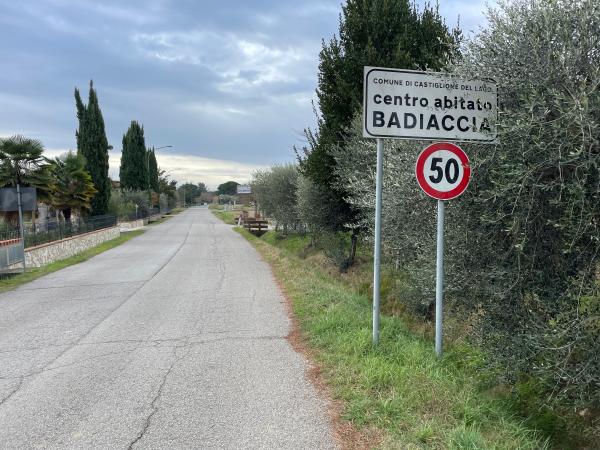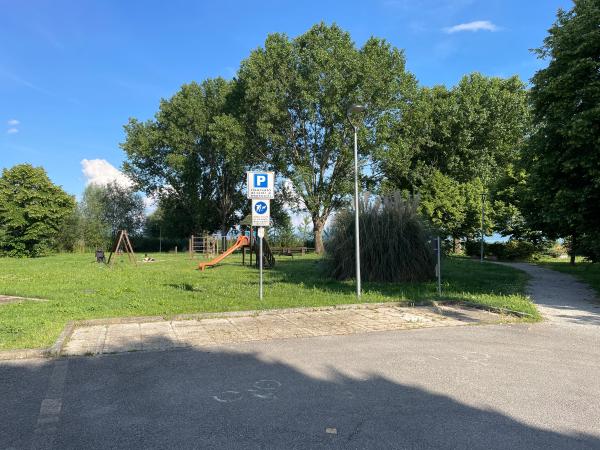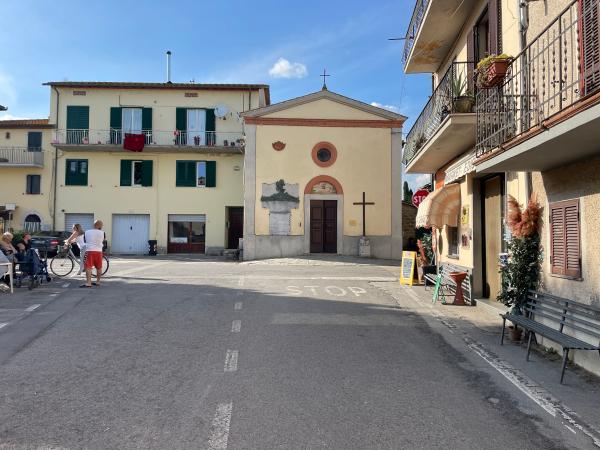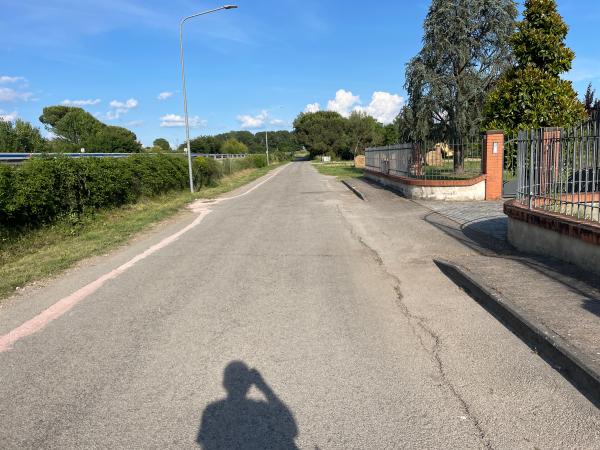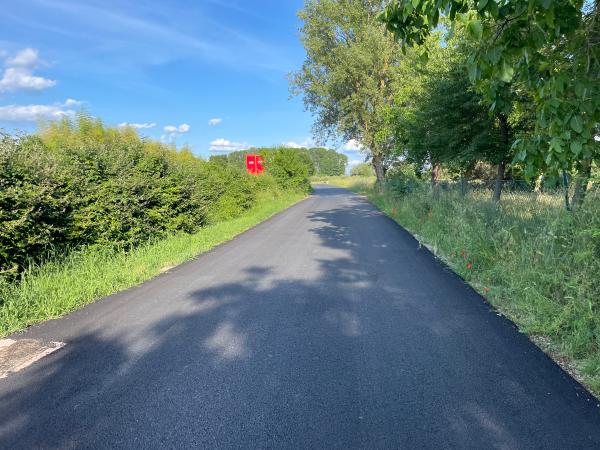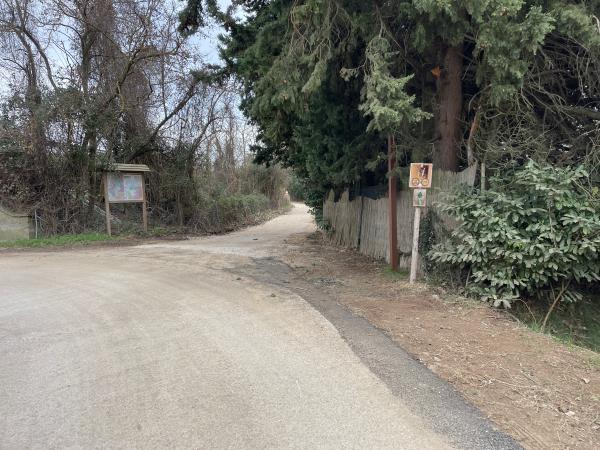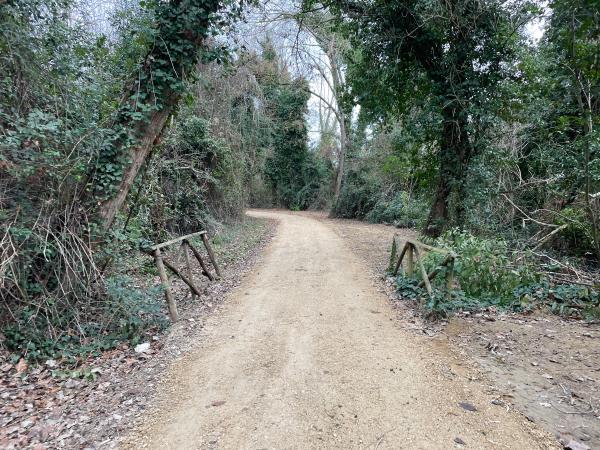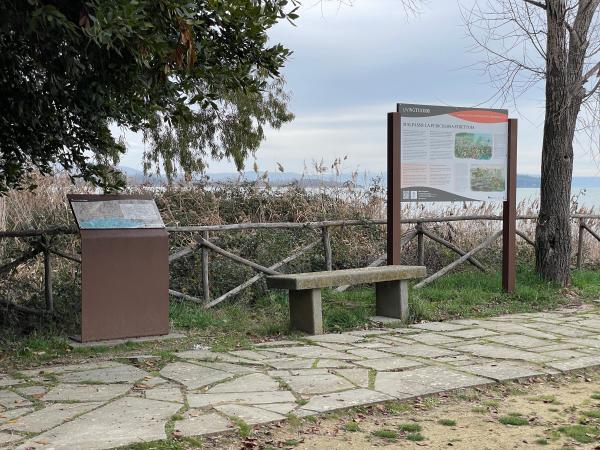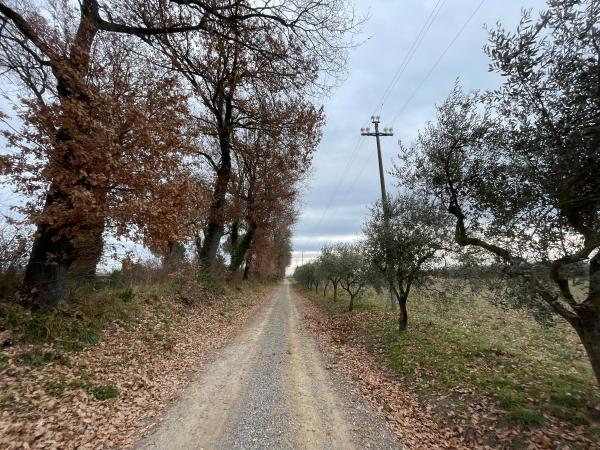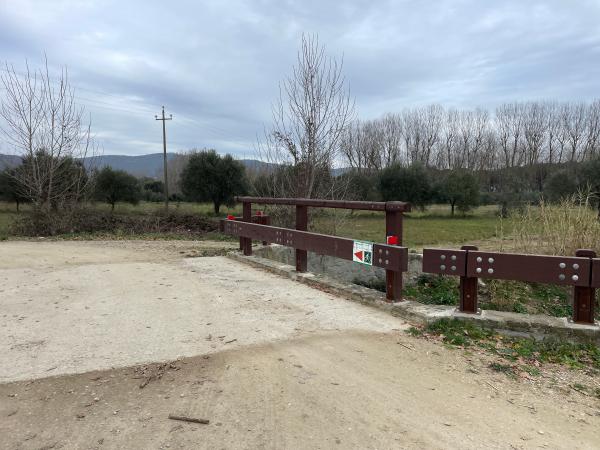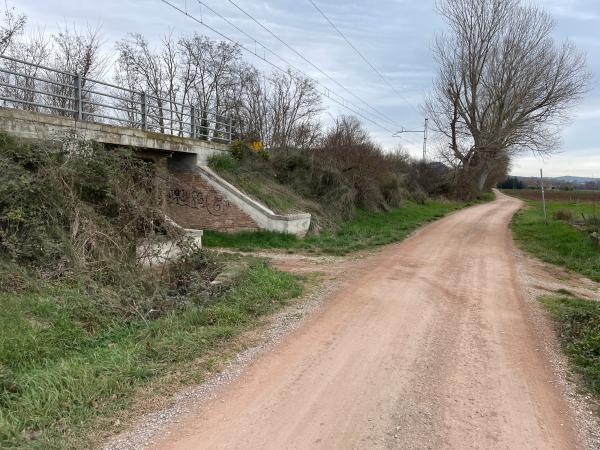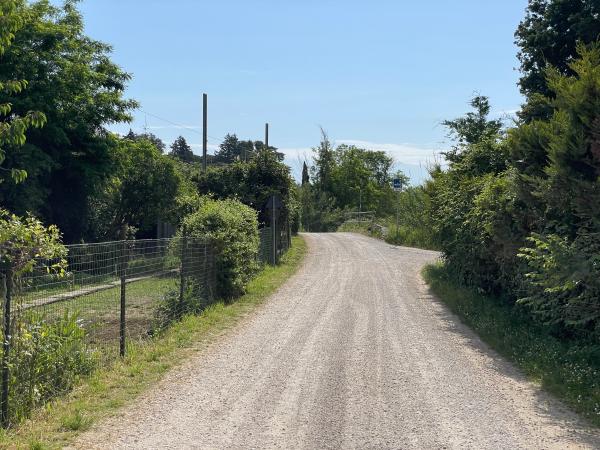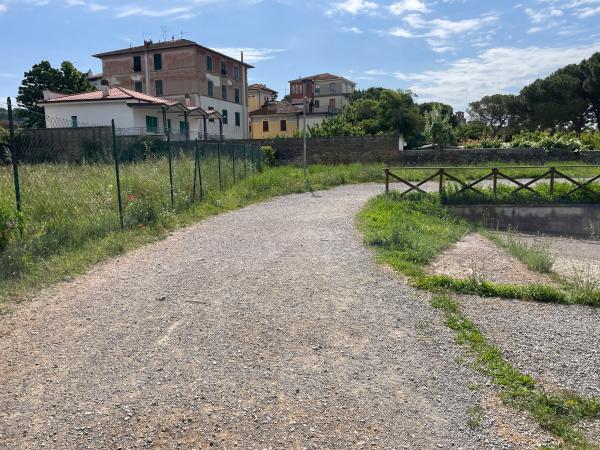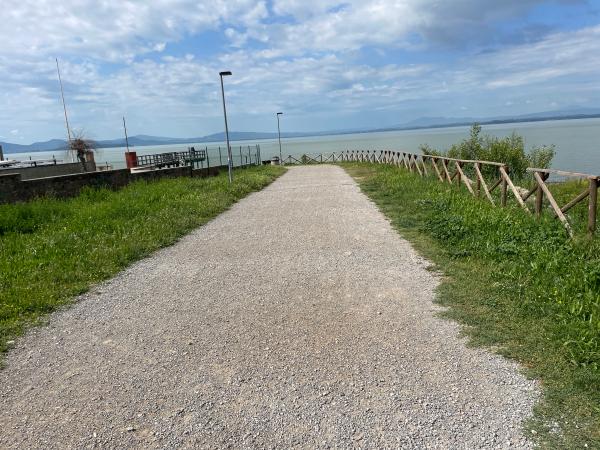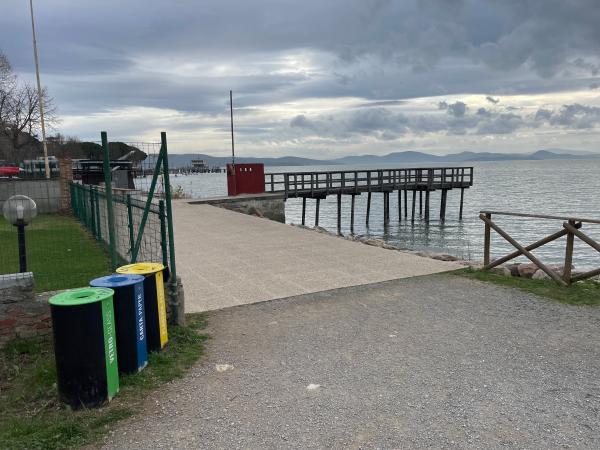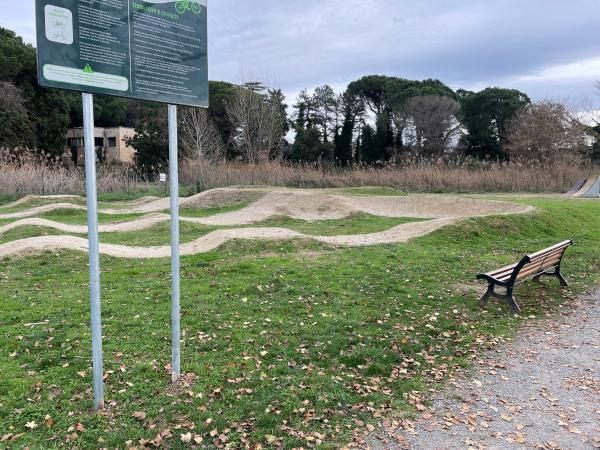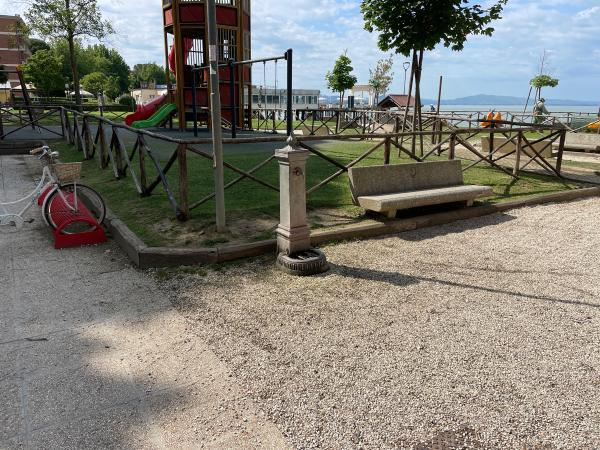Trasimeno for everyone - cycle route - Trasimeno for everyone - cycle route
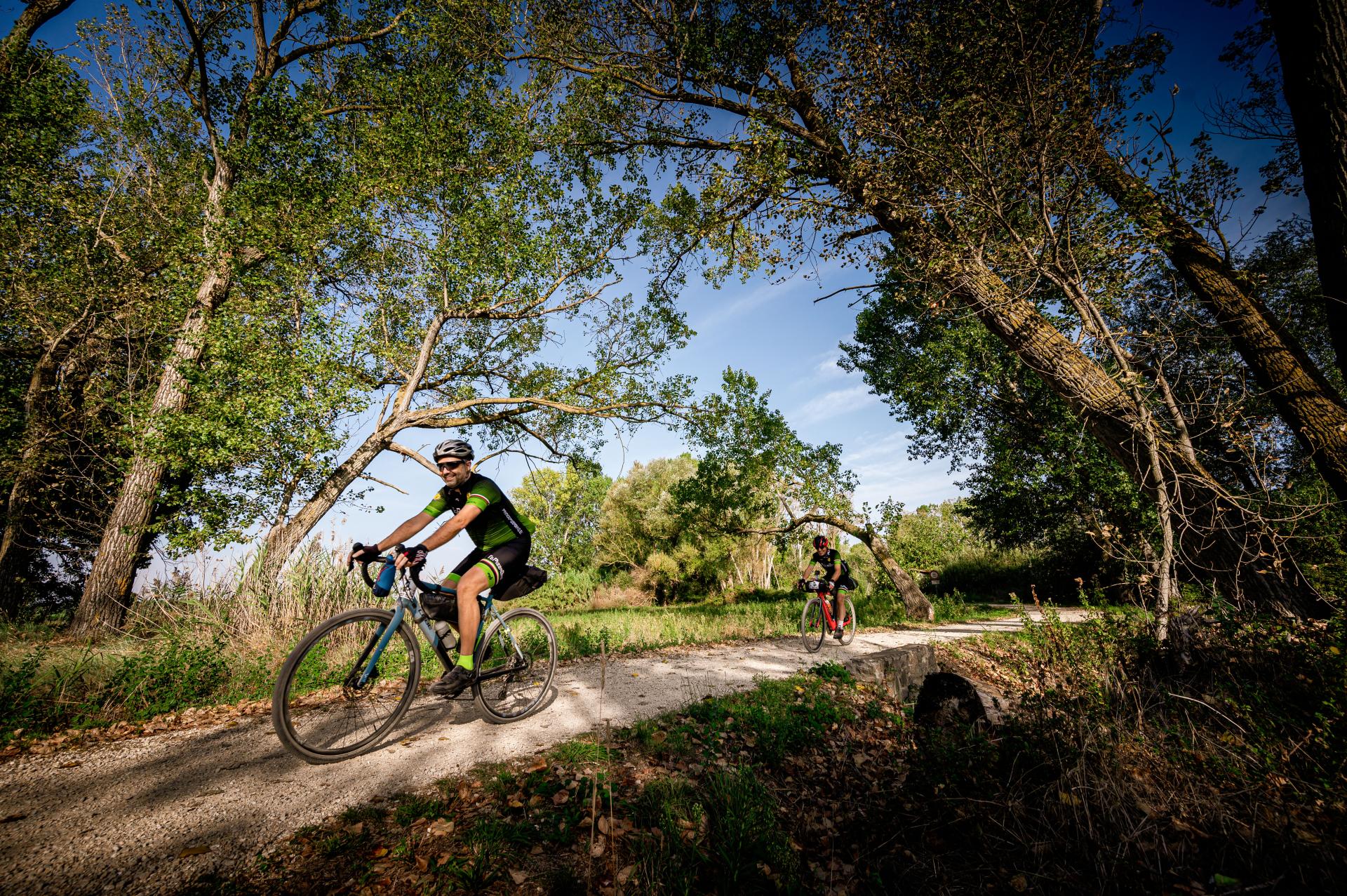
Trasimeno for everyone - cycle route
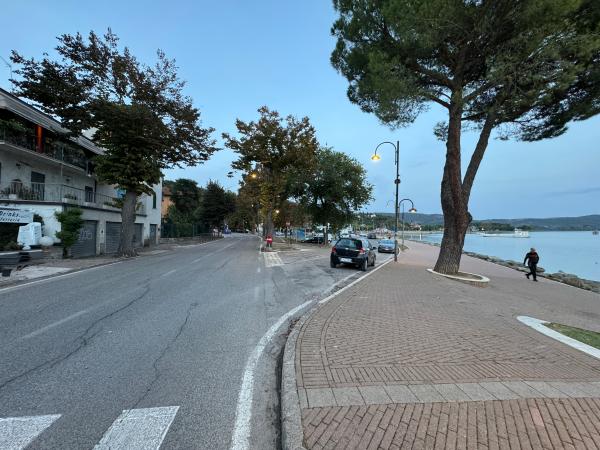
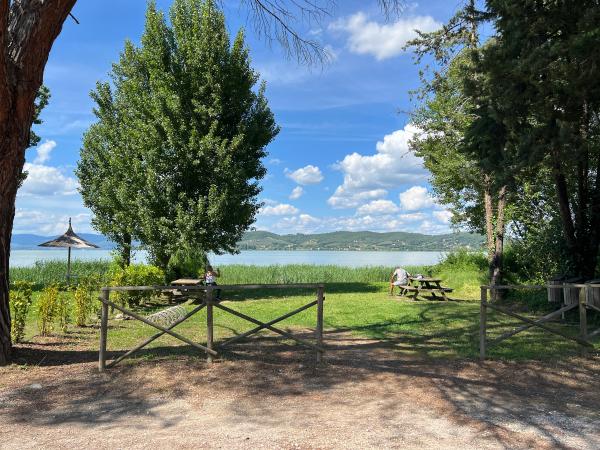
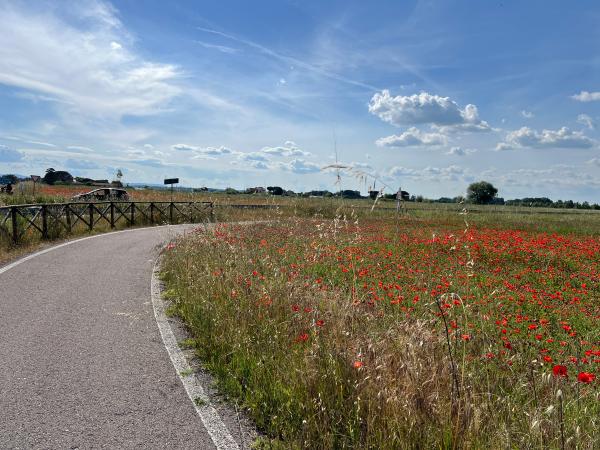
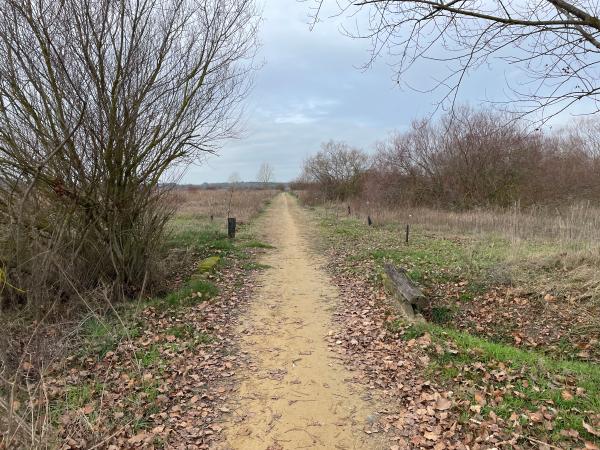
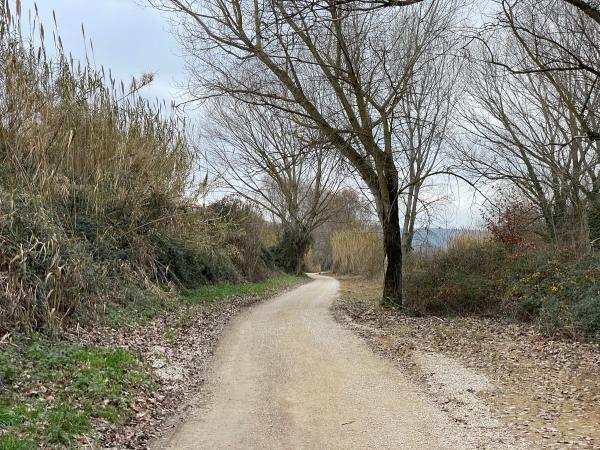
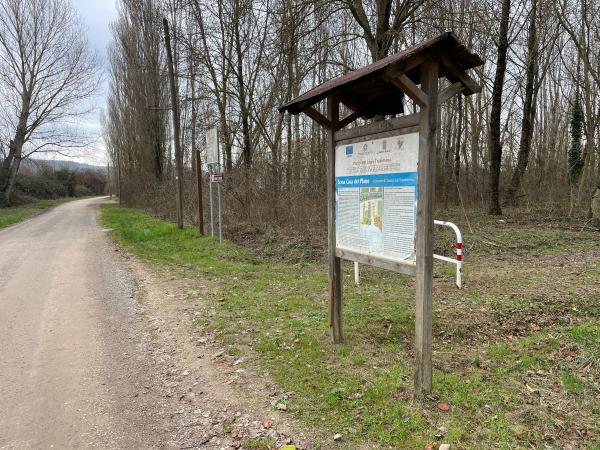
-
Positive height difference : +28 m
-
Negative height difference : -40 m
-
Maximum slope : 5%
- A large part of the route runs parallel to the railway: passing trains can cause sudden loud noises.
- The route is mostly unshaded.
The travel times are estimated for an average user accustomed to outdoor activities, who travels the cycle route for leisure purposes, with no sporting performance purposes.
Average travel speeds taken into account when calculating travel time:
Bike: 15 km/h
On foot: 4 km/h
Self-propelled wheelchair: 5.5 km/h
Electric wheelchair/electric scooter/with electric handbike attachment: 8 km/h
This section of the Trasimeno Cycle Route begins at the public car park in Piazza Eduardo Acton in Passignano sul Trasimeno. Here we can find a drinking fountain, benches and picnic tables, while nearby, along the lakefront and towards the centre of Passignano sul Trasimeno, we can also find cafes and refreshment facilities. At the end of the car park, in a small wooden house, we find the accessible public toilets.
We leave the car park by taking the ramp of a blue-coloured asphalt cycle path: the ramp, which is about 5 metres long, has a gradient of about 10 per cent. The cycle path continues parallel to but separate from the regional road (via Europa). We are protected from heavy traffic, but our route is still accessible to cars and we may also encounter people on foot. At the end of the blue lane, we reach a toboggan that allows us to descend to the level of the dock, where we also find public toilets and a car park with spaces reserved for people with disabilities. The road has a gradient of around 6%.
We walk along the car park and then up to the level of the regional road, with a ramp with a gradient of around 6 per cent that leads us into the traffic. On the right-hand side there is a pedestrian pavement accessible by a ramp and wide enough to allow the passage of one mobility aid at a time, paying attention also to the sections where the asphalt is not well smoothed and gives rise to treacherous counter-slopes. Bicycles, on the other hand, must proceed on the regional road, paying close attention to the often heavy traffic. The railway also runs on the other side of the road and passing trains can cause sudden, loud noises.
After about 200 m, those walking along the pavement must cross the road at the traffic lights at a pedestrian crossing and then cross again after another 100 m or so. The pavement ends after 150 m, opposite Camping Kursaal.
For 50 metres, we ride along the road without protection from vehicles, but we leave it and take the asphalt track to the right, covered in gravel, which, after an initial hump, descends with a gradient of around 10-15% for about ten metres and then flattens out. From here, the cycle track becomes about 2.5 to 3 metres wide, and it may happen that we cross a few cars heading for the private properties bordering the path and that we cross the train passing on the railway line parallel to our route.
After 700 m, the ground becomes asphalted at a road that leads off to the left and where care must be taken. We then face two ascents and descents on asphalt, the gradients are around 10% for a distance of 60 m.
We thus arrive at Camping Trasimeno and, from this point, the wide, flat and well-beaten asphalt track covered with gravel resumes. Only at certain points does the gradient increase to 5-6% for short stretches to allow us to cross some ditches. At some points we briefly find ourselves on asphalt sections at the junction of a few roads.
The most critical aspects of this section are certainly its proximity to the railway, which is only a few metres away with no guards or barriers to dampen the noise. Although trains pass infrequently, it is still possible to witness their passage. Additionally, the path is poorly shaded.
-
Positive height difference : +33 m
-
Negative height difference : - 34 m
-
Maximum slope : 15%
- Mud puddles can be found in the shady dirt track adjacent to the Albaia lido.
- The route is mostly unshaded.
The travel times are estimated for an average user accustomed to outdoor activities, who travels the cycle route for leisure purposes, with no sporting performance purposes.
Average travel speeds taken into account when calculating travel time:
Bike: 15 km/h
On foot: 4 km/h
Self-propelled wheelchair: 5.5 km/h
Electric wheelchair/electric scooter/ with electric handbike attachment: 8 km/h
Regarding accessibility information, the route starts from the car park in Via del Pontile in Torricella. Next to the car park is a public park equipped with benches and a drinking fountain where you can fill your water bottles and refresh yourself. The cycle path passes in front of the pier in Torricella, which has a concrete bottom and is about 2.5 metres wide; it has a ramp that guarantees access, but it is not delimited at the walking surface by continuous sidewalks and does not have a footpath marker; however, there are tubular banks that guarantee safety.
From Via del Pontile we reach Viale del Lavoro, which also coincides with SP 316: the road has pavements for about 90 metres, in some places less than 70 cm wide. At the end of the pavement, we continue on the cycle/pedestrian path that runs along the provincial road, separated by a guard-rail.
From this point, for about 1.7 km, the surface is asphalt on which gravel has been spread, which accumulates near bumps and dips, reducing the grip of the wheels especially when cornering or braking sharply. For the most part, the course is flat or with very slight undulations, but at ditches and private driveways there are short ramps with an uphill and downhill gradient of 5-10%, about 10-15 metres long.
At the Albaia Lido (equipped with accessible toilets when the place is open), the cycle path enters between two rows of maritime pines, which shade the route for a few dozen metres and, at the same time, the ground is made of gravel; in the event of rain, it can result in muddy puddles. After about 400 metres from the lido, the surface becomes asphalted, but the reserved cycle/pedestrian path continues, sheltered from motor vehicle traffic.
After about 200 metres, the gravel resumes with a flat section under trees that provide some shade. The gravel road continues for about 900 metres until it reaches the Monte del Lago jetty, built of concrete and about 2.5 metres wide: again, there are no side banks at the footpath level and no footpath markings, but there are tubular banks that guarantee safety.
At the pier, where we also find a small car park with a place reserved for people with disabilities, a flat stretch of asphalt begins with a dirt track on either side. After a few metres we leave the town centre and a beautiful view of the lake opens up on one side. After another 200 metres we find the asphalt surface covered with gravel, which we must pay attention to due to grip problems. The route is still mostly flat with short ramps of 10-15 metres and a gradient between 5 and 10%. At the last houses of Monte del Lago we also find a drinking fountain.
Immediately afterwards, the cycle route begins to run parallel to Provincial Road 316, remaining separated from it by a ditch and crossing an area of meadows and cultivated fields; occasionally, even in this section we will find short ramps to climb over ditches and driveways. After 700 metres, the gravel path joins the asphalt without any footpath markers or kerbs and, for only a few metres, there is no longer a physical separation between the provincial road and the cycle route, which then become separate again.
After another 900 metres, however, we leave the gravel for good and the cycle route joins the provincial road: here too there are no pedestrian signalling elements or kerbs.
Paying close attention to motor vehicle traffic, we thus encounter the first houses of San Feliciano. After about 570 metres along the provincial road, we turn towards the lake and take the first side road that leads to the Lungolago Pace e Lavoro. In the public park bordering the lake we find benches, cafes, restaurants and a fountain. Accessible public toilets are located at the end of the stage, in the large public car park Lungolago Alicata.
-
Positive height difference : +60 m
-
Negative height difference : - 65 m
-
Maximum slope : 25%
- Two sharp bends with a gradient of 25 per cent transverse and around 8 per cent lateral, on an asphalt track strewn with gravel that cannot be bypassed by alternative routes.
The travel times are estimated for an average user accustomed to outdoor activities, who travels the cycle route for leisure purposes, with no sporting performance purposes.
Average travel speeds taken into account when calculating travel time:
Bike: 15 km/h
On foot: 4 km/h
Self-propelled wheelchair: 5.5 km/h
Electric wheelchair/electric scooter/with electric handbike attachment: 8 km/h
The route starts from the car park on the Alicata lakeside in San Feliciano, near which we can find a public park, cafes, restaurants, and a drinking fountain to fill water bottles and refresh oneself. In the car park, we find accessible public toilets.
The cycle route leaves the lake behind and heads towards Provincial Road 316/1, on a two-way paved road with pavements on both sides. When we reach the Provincial Road, which here takes the name Via della Concordia, for about 100 metres, we can walk along the pavement on the right side of the road. Then the pavement ends and we have to get onto the asphalt. After about 180 metres, we leave the asphalt and find the asphalt track covered with gravel that runs along the provincial road. We will be separated from motor vehicle traffic by guard-rails.
We then continue on the gravel road, skirting cultivated cereal fields along the banks of the lake. The route is mostly flat or with slight undulations, but near the ditches, there are short ramps with an uphill and downhill gradient of 5-10%, about 10-15 metres long.
After about 1.5 km we reach a wooden bridge that allows us to cross the course of the Caina stream. To reach it, the path runs up a ramp about 30 metres long, with a gradient of around 5-8%. To climb up and down from the bridge, a 2-3 cm step must be overcome; the structure has parapets that guarantee its safety and reach the walking surface.
After about 50 metres, we reach the entrance gate to the La Valle Nature Reserve. Here we find a large, unattended car park. We also have the possibility of staying in a facility adapted to the needs of people with motor disabilities.
Once past the car park, we find the first major critical point of this section of the Trasimeno cycle route: the path takes a very narrow double hairpin bend with a slightly oblique surface, with an average gradient of between 25 and 30 per cent. Because of the gradient, the gravel tends to become thicker here and further diminish the grip of the wheels on the ground. It is therefore advisable to approach the curve with caution and pay close attention to both lateral stability and braking.
With great care, it is possible to avoid this point by passing onto the Provincial Road when you reach the car park and following it for about 200 metres. However, one has to be very careful because a curve limits the visibility of drivers, and the traffic is heavy.
After the double hairpin bend, the cycle route climbs back up to road level, with a gentle, even ramp and the usual gravel surface covering the asphalt. We follow it for about 500 metres, skirting the provincial road on a flat section separated from motor vehicle traffic by a wooden guard rail. We then reach a point clearly identifiable thanks to the presence of some large cypress trees shading a picnic table.
Here the cycle route turns away from the asphalt road again and heads slightly downhill (5-10%) through cereal and alfalfa fields. We follow it for about 1.7 km until we come to the second critical point.
At a bend, the route approaches the Provincial Road again, with a climb of about 300 metres at 30-35% and a second narrow bend with a transverse slope of about 5%. Here, too, the gravel tends to accumulate more than elsewhere, making the road surface very loose. This section should be approached with caution regardless of the vehicle used, especially by those who use mobility aids, and unfortunately, it does not offer more accessible alternatives.
A few metres after the sharp bend, the cycle route flattens out again, having reached the level of the provincial road, which remains for a few dozen metres partially hidden by a strip of trees and bushes.
The cycle route rises to the level of the Trasimeno Inferiore Regional Road 599 at Ristorante Faliero, which has a large car park on the opposite side of the tarmac road. The route, again with an asphalt surface covered with gravel, becomes flat again and continues for about 500 metres parallel to the asphalt road, which is normally very busy, and from which we are separated by a few metres also thanks to the presence of a guard rail. We then encounter a private house and, for about a hundred metres, there is no longer any separation between the cycle route and the asphalt road. At the end of the private property, the asphalt track covered with gravel again moves away from the asphalt road, proceeding parallel to it at a distance of a couple of metres with the protection of a guard rail for about 300 metres.
We then follow the route of the cycle route, and reach the parish church of Santa Maria de Ancaelle, at which point the route turns to approach the lake, which we reach in about 200 metres along a slightly downhill route. We find ourselves in front of a wetland area characterised by a thick reed thicket: here it is sometimes possible to spot some wild birds, which find their ideal habitat here.
The cycle route makes another sharp change of direction to the west, skirting the reeds and, after just under 300 metres, we find an area equipped with picnic tables and a bicycle rack. We then turn away from the lake and, in about 60 metres, we cross Regional Road 599 again. We take it and, for about 250 metres, we have to merge into the traffic and the cycle path no longer has a protected seat: we must be very careful here because the traffic is heavy and the road makes a curve that does not guarantee optimal visibility.
Continuing, we take the protected cycle route, made of asphalt covered with gravel and separated from the regional road by a guard rail. In the section that follows, the route is essentially flat, with short ramps at ditches and junctions with side roads. After about 800 metres, the guard rail is interrupted and the cycle path joins the regional road without any protection, except for a kerb, which is interrupted at the entrances to private property: the surface becomes asphalted and, having passed a private house, the cycle route is flanked by a double wooden balustrade and pedestrian pavement.
Approaching the village of Sant'Arcangelo, we turn onto the first dirt track that branches off in the direction of the lake. Following it, in 250 metres, we come to a concrete bridge accessed by a chamfered step about 2-3 cm high and flanked on both sides by a metal balustrade with a continuous base wall.
We cross the bridge and at the next junction, on the right, we find the public car park where this section of the Trasimeno cycle route ends. The car park is equipped with a space reserved for recharging electric vehicles, but has no spaces reserved for people with disabilities.
-
Positive height difference : +55 m
-
Negative height difference : -40 m
-
Maximum slope : 10%
- A section of approximately 200 metres of dirt track with a rough surface, with large deep potholes that tend to create muddy puddles.
- Entrance to Castiglione del Lago on cycle path with no physical separation from motor traffic.
The travel times are estimated for an average user accustomed to outdoor activities, who travels the cycle route for leisure purposes, with no sporting performance purposes.
The route starts from the car park along Via Martiri di Cefalonia in Sant'Arcangelo. The car park is free of charge and houses a charging station for electric vehicles, but has no reserved spaces for people with disabilities. We leave the car park behind us and turn into via Martiri di Cefalonia, a secondary asphalt road slightly uphill, where it is possible to encounter a few passing vehicles. Along the street are a few unshaded benches. Some restaurants and accommodation can be found nearby.
We take the first crossroads on the right and the asphalt gives way to dirt road. We proceed for about 1.5 km on secondary asphalt road sections that alternate with dirt road sections, paying attention to the possible presence of motor vehicles. We then cross Regional Road 599 (Via della Sapienza) near an ice-cream parlour. From this point, for about 270 m, we can follow a section of cycle/pedestrian path built on the edge of the regional road, separated from it by a kerb, which is interrupted at the driveways providing access to private homes. Once past the last houses, the bottom of the cycle path becomes asphalted with a gravel covering and, after a few dozen metres, the route turns away from the regional road, enters fields and approaches the lake. At ditches and road crossings, the track inclines for a few metres at 5-10% with short ramps. About 3 km from the Sant'Arcangelo car park, there is a stairway that allows one to climb to the Panicale belvedere and, on the opposite side, the wooden footbridge of the Punta di Braccio tourist pier, which allows one to approach the lake shore and observe the wild birds that inhabit the reed thicket. The gangway is made of wooden planks and is 165 cm wide. The side walls are made of reed and wooden planks and deviate a few cm from the floor, making it difficult to follow the perimeter with a stick. After a few metres, the side walls break off and one can stand on a raised platform overlooking the reedbed: it is accessible and wide enough to allow one bicycle or wheelchair user at a time to manoeuvre, but has no side parapets.
Having left the gangway, we continue on a gravel section that winds through the reed beds and then again approaches the regional road with a ramp at about 5 per cent that is about ten metres long. When we reach the road, we ride alongside it on a cycle path with an asphalt surface, separated from the car traffic initially by a guard rail and then receding by about 3 metres. Here too, at ditches and road crossings, the track inclines for a few metres at 5-10% with short ramps.
After about 1.5 km, we enter Mirabella. The cycle route approaches the road again and is separated from traffic by a concrete kerb. Care must be taken because the surface of the cycle path is here inclined sideways at a 5% gradient for about 100 m to allow cars to enter private homes. Afterwards, it becomes flat again.
Leaving Mirabella, the cycle route moves away from the road and into meadows and fields, while the road surface remains paved. Approximately 500 m after leaving Mirabella, we leave Regional Road 599 to begin flanking Provincial Road 303: the roadbed here is paved and covered with gravel, but remains flat. After a little less than 600 m we approach the lakeshore again with a 90° bend. After another 500 m or so, we turn left onto a gravel road. From this point, for about 1.6 km, the road surface is rather uneven, with large potholes up to ten centimetres deep, which tend to fill up with water and mud in the rain, making it difficult for wheelchairs or other aids to pass.
After skirting the Anguillara ditch for a few hundred metres, we join the SP 303. At the crossroads, which is neither protected nor signposted, we must be careful because we are not very visible to vehicles coming from the left. We then leave the asphalt road after a few metres, to resume our route on a protected road with an asphalt surface covered with gravel. Every time we cross a side road, we also encounter metal arches that prevent cars from entering and occupy about 1/3 of the width of the path, leaving 1 m for passing on either side.
After about 600 m, we again enter the provincial road without any protection or footpath signs: this time we will have to continue on the provincial road, paying close attention to vehicles proceeding at high speed, for about 2.2 km. We can then return to a cycle/pedestrian path on a protected roadway and an asphalt surface covered with gravel for about 385 metres. At the end, we must cross a secondary asphalt road, paying attention to the cars coming around the bend on the left; we then continue along a paved cycle/pedestrian path, separated from the traffic by a kerb, which, after a few dozen metres, gives way to a short stretch of gravel road with a grassy strip in the middle, which, after about 500 m, crosses the Pescia ditch with a small bridge made of wire mesh. The bridge is approximately 1.65 m wide and has continuous banks that connect with the pavement with no steps on either side. After crossing the bridge, we return to the asphalt and gravel path and follow it for approximately 2.2 km. When this ends, we continue on the cycle-pedestrian lane built on the edge of Regional Road 71ter: the path is made of red asphalt and, although it is approximately 2 m wide, it is not physically separated from the roadway.
In a few tens of metres, we reach a roundabout and follow the cycle track that takes the first street counterclockwise: viale Divisione Partigiani Garibaldi. We thus reach the area of reeds that precedes the tourist port of Castiglione del Lago and then the public park. Once past the port, the cycle path loses its red colour, but is flanked by a pavement dedicated to pedestrians
-
Positive height difference : +50 m
-
Negative height difference : -50 m
-
Maximum slope : 5%
- The cycle route follows paved roads for two long stretches where traffic is sometimes quite heavy and there are no pavements or lanes reserved for pedestrians or cyclists.
- The route has about 1 km of dirt tracks even less than 50 cm wide through flat but uneven fields.
The travel times are estimated for an average user accustomed to outdoor activities, who travels the cycle route for leisure purposes, with no sporting performance purposes.
Average travel speeds taken into account when calculating travel time:
By bike: 15 km/h
On foot: 4 km/h
Self-propelled wheelchair: 5.5 km/h
Electric wheelchair/electric scooter/with electric handbike attachment: 8 km/h
The route starts in Castiglione del Lago from the car park in via Lungolago, where the cycle route corresponds with a cycle lane carved - without a physical separation - into a lane of the road also used by motor vehicles: the side pavement guarantees the safety of pedestrians and wheelchair users. There is a drinking fountain near the starting point of the route. About 1.8 kilometres after the start of the route, we find a charging point for e-bikes. We continue on and, a few metres after the entrance to the Listro campsite, at a roundabout, we leave the asphalt road and take a narrow gravel track on the right, slightly downhill. The turnoff is not signposted with footpath markers and, for the first 100 metres, the track on which we enter is about 2 metres wide, enough for one bicycle or mobility aid at a time, but allows two-way traffic with some care. The width increases after a short bend; the surface is light but well-trodden gravel. The presence of a few trees provides a little shade at certain times of the day. After about 130 m, at a fork, we continue on the gravel track, entering a wooded and unevenly shaded area. Along the entire section, one can encounter fields of grasses and tall trees including white poplars and other plants typical of water-rich plains.
After a further 100 metres or so, we cross a small bridge accessed by a step of approximately 3 cm. The bridge is wide enough to allow the passage of two vehicles at the same time; it is made of concrete with metal sides that are high in accordance with the law, with the skirting board that does not connect directly with the walking surface. After crossing the bridge, with a new step of about 3 cm, a section of very loose gravel begins, which risks causing the wheels of bicycles and mobility aids to lose grip. After about 40 metres, the gravel track gives way to a section of single track, with a track about 30 cm wide with a beaten surface through a grassy meadow with an uneven surface where, at certain times of the year, there is also the risk of high grass. After about 50 m, the dirt track widens a little. From this point on, the surface is quite uneven: a mixture of beaten earth, patches of grass, gravel and in places even sand, which certainly makes access to mobility aids more difficult. The width varies between 1.10 m and 30-40 cm with grass on both sides. At a small bridge over a ditch, marked by a concrete hump, large stones also emerge from the bottom of the track. This section, which is somewhat complex in terms of accessibility, is approximately 1.5 km long.
Continuing on, the track widens to a width of 1.5 metres, with a regular gravel surface. The track winds along the edge of the bush. After about 600 m, we reach a small footbridge accessed by a concrete step about 3-6 cm high; the bridge is in excellent condition, is as wide as the beaten track and has a well-connected wooden plank floor, with banks also made of wooden planks; the skirting does not connect with the floor.
After crossing the bridge, in about 300 metres, we come to a section in which the characteristics of the track's width and surface remain constant, but the scrub gives way to a series of abandoned buildings, from which a fence separates us. After a hundred or so metres we come to a crossroads with a secondary asphalt road with very little vehicular traffic, lined with rows of maritime pines: we turn left, taking it for a hundred or so metres and then leaving it to turn right onto a gravel track. The entrance to the track is obstructed by the presence of a cement bollard that leaves a gap of about 1 metre on either side. The gravel track is about 1.5 metres wide with a bottom with a few holes in the first few metres. On the left side are cultivated fields, while on the right we skirt a pine forest. After about 500 metres we find the first rest area in this section, after which we pass a small bridge. Here too, access is via a chamfered step of about 3 cm. The route winds through a very airy thicket, which provides at least partial shade in the mornings except during the central hours of the day.
After about 150 metres and then after a short distance, we come across a fourth and a fifth bridge, quite similar to the previous two: the second one has concrete access steps of 4-5 cm in height. As we descend from the fifth bridge, we must be careful because the gravel track makes a gentle downhill bend. We then continue along the gravel track, which is just under 2 metres wide and essentially flat, until we arrive at the next bridge, which is very similar to the previous two, with a slight ascent of about 2%.
Approximately 1.5 km from the previous one, we encounter a second rest area, equipped with a bench that may be covered by vegetation if it is not recently maintained. After a few dozen metres, we encounter another bridge, with similar characteristics to the previous one. Within a few dozen metres we find a third rest area equipped with a picnic table. The next area, equipped with a bench shaded by some trees, is about 400 metres further on.
The track becomes a little winding and, in 200 metres, leads us to the eighth bridge in this section, identical in construction to the previous ones, with concrete access steps approximately 3 cm high. After the bridge, we leave the shady thicket to cross a section of open countryside with a reed thicket stretching between us and the lake. After about 500 m, we find a last wooden bridge, similar to the previous ones, with a concrete access step about 5 cm high. After the bridge, the track winds its way through fields and reeds, sometimes offering good shade.
After about 300 metres, we arrive at the La Sosta del Priore restaurant. From here, the gravel track becomes more uneven, with some narrower sections, a central grassy hump, stones and surfacing roots. In about 400 metres we arrive at the entrance to the Badiaccia campsite.
We take a stretch of uneven asphalt road, which we follow for a few dozen metres until we cross, slightly uphill, State Road 75 of Trasimeno, which we take to the right, following it for about 900 m slightly downhill (2%). The road is dual carriageway and the cycle track proceeds on the same carriageway as the cars, with no protective kerbs or visual distinguishing features. The entrance is not signposted with pedestrian elements. We thus enter Borghetto. To reach the car park by the lake, we continue straight on to the village square, where there is also a drinking fountain, shaded benches and a grocery shop, and turn right, following the signs for Lake Trasimeno. We encounter two speed bollards and then continue straight on to the free car park, with some spaces reserved for people with disabilities.
The park adjacent to the car park is accessible via a wide gravel path and is equipped with benches and picnic tables. There are no public toilets and the access to the jetty has a step about 10 cm high.
-
Positive height difference : +20 m
-
Negative height difference : -20 m
-
Maximum slope : 5%
- The route runs parallel to the railway: passing trains can cause sudden loud noises.
- On stretches of dirt road, it is possible to encounter potholes and unevenness in the surface.
The travel times are estimated for an average user accustomed to outdoor activities, who travels the cycle route for leisure purposes, with no sporting performance purposes.
Average travel speeds taken into account when calculating travel time:
By bike: 15 km/h
On foot: 4 km/h
Self-propelled wheelchair: 5.5 km/h
Electric wheelchair/electric scooter/with electric handbike attachment: 8 km/h
The route begins in Borghetto, from the car park adjacent to the camper van area. We head towards the village, along a small asphalt road with no pavement or pedestrian lane but little traffic. We thus reach the village square, where there is also a drinking fountain and a grocery shop. We turn right onto Regional Road 75, which, as we leave Borghetto, becomes Via Puntabella: the road is asphalted and shared with motor traffic, but there is a pedestrian pavement on one side. The asphalt is uneven, with potholes and patches. Soon the road joins the Bettolle-Perugia motorway, which passes a few metres away: heavy traffic is visible and can create noise, but the route is completely safe. Leaving the village, the pavement ends but the road has a side lane for pedestrians and the asphalt soon becomes smoother.
About 1 km from the Borghetto square, at a tunnel under the motorway, we leave the asphalt and take a gravel-covered dirt track that, in the rain, can create puddles and mud, especially where it has holes and depressions. We cross a wooded section and the track is flanked by trees and reeds. After a little more than 1 km, the track makes a double bend and leads us to a rest area with panels indicating the site of the Battle of Trasimeno. The paving of the area is in poor condition: there are a few stone benches and a small wooden pier, accessible by means of a rudimentary ramp made of a 30-cm wide tile that allows one to cross a sinking about 25 cm deep; the pier, however, has banks made of wooden planks that do not connect directly to the walking surface, which itself has a few uneven spots.
Continuing on, the dirt track has a few more stone benches and is flanked by a fence on one side and a wooden balustrade on the side facing the lake. The track narrows to a width of 2.5 m and, for about 1.9 km, continues to have a fairly even gravel surface, but subject to the formation of puddles in the event of rain at potholes and depressions, which are, however, rare.
At the end of this section, we turn right onto a track that has the same characteristics but a more compact and regular surface: we follow it for about 600 metres between fields and a tree-lined ditch, until we reach a small cement bridge over which we must turn left. The bridge is accessed by a step of about 2 cm; the parapets are made of solid wood and have a concrete kerb to connect with the pavement. Immediately after the bridge, we turn sharply left onto a gravel-bottomed track similar to the previous one.
After about 600 metres, in front of a railway subway, we turn sharply onto a gravel path and pay attention to the intersection with the asphalt, which is uneven. On the side bordering the railway, the path is lined with trees and shrubs, while on the side towards the lake we have fields and olive groves. On this stretch, it may happen that we encounter motor vehicles and we must pay attention to the presence of some potholes up to ten centimetres deep and up to 50 cm in diameter.
After about 500 m, we reach a climb of a few metres at 5% that leads to the intersection with a small asphalted road. We continue straight ahead and, after less than 100 m, slightly downhill, we reach the intersection with via Navaccia, which is asphalted and where we may encounter more motor vehicle traffic. We take it in the direction of the lake and reach the Punta Navaccia car park, where this section ends.
Nearby, there are several cafes and refreshment facilities, public toilets, the jetty from which ferries depart for Isola Maggiore, and the charming open-air museum of Campo del Sole.
-
Positive height difference : +25 m
-
Negative height difference : -17 m
-
Maximum slope : 5%
- The route runs parallel to the railway for long stretches: the passage of the train can cause sudden loud noises
- On stretches of dirt road, it is possible to encounter potholes and unevenness in the surface.
The travel times are estimated for an average user accustomed to outdoor activities, who travels the cycle route for leisure purposes, with no sporting performance purposes.
Average travel speeds taken into account when calculating travel time:
By bike: 15 km/h
On foot: 4 km/h
Self-propelled wheelchair: 5.5 km/h
Electric wheelchair/electric scooter/with electric handbike attachment: 8 km/h
This section of the Trasimeno Cycle Route begins at Punta Navaccia, in the municipality of Tuoro, at the car park adjacent to the open-air museum of Campo del Sole. Here we can find cafés, refreshment facilities and accessible public toilets.
We take the asphalt road via Navaccia that leads us, slightly uphill, to cross the gravel track of the Trasimeno cycle route. We take it, turning right. The track is about 2.5 m wide and allows bicycles and mobility aids to pass simultaneously in both directions. The surface is fairly even with rare potholes. From the beginning, the route runs through a wooded area that provides irregular shade, and then opens up as we pass through fields and reed beds. Although this section of the cycle path is unpaved, it is not closed to cars and it is possible to cross a few vehicles. The route runs parallel to the railway line, at a distance of about twenty metres: if a train passes, the noise is very loud. We will have to deal with climbs of a few metres in length with a gradient of around 5% at ditches or driveways.
After about 2.5 km, the cycle route moves slightly away from the railway line and we pass the municipal water purification plant. After about 350 m, we face another short climb to reach a crossroads: we ignore the level crossing on the left and the driveway of a private house on the right. Instead, we continue with a descent of around 7%, about 50 m long, continuing parallel to the railway for about 1 km, always bearing in mind the possibility of trains passing by and the presence of some cars and pedestrians who frequent this stretch of the route for recreation, since it is very close to the centre of Passignano.
We avoid the railway subway that opens to our left at Scesa della Vigna, and instead turn right as we enter Passignano Park, heading towards the lake. We pass in front of the Passignano Bike Pump Track, where there are some bike stunts and benches. After about 400 metres, we pass a slipway for pulling boats ashore and our track presents a counter slope of a few degrees towards the lake, before turning slightly downhill to arrive, after about 80 metres, at the end of the dirt track. Here begins a tiled pavement that can be accessed without difficulty. After 20 metres, at a small jetty, however, a tiled ramp allows us to overcome the step about 20 cm high.
After the headquarters of the Passignano Rowing Centre, we turn left onto a red-bottomed cycle path shaded by maritime pines. After passing an area equipped with children's games, we find nearby public toilets that are not equipped for people with accessibility needs, a drinking fountain and a bench for a rest.
Here we turn right, and follow the path along the edge of the lake, paying attention to the somewhat narrow passage without protection or guardrail along the dock. We encounter several cafés and refreshment facilities and then exit to walk along the wide tiled pavement along the heavily trafficked Via Aganor Pompili at the boat jetty.
We continue straight ahead until we reach, after about 200 metres, the public car park in Piazzale Eduardo Acton, near which there is also a drinking fountain. The lakeside promenade is equipped with benches evenly spaced.

